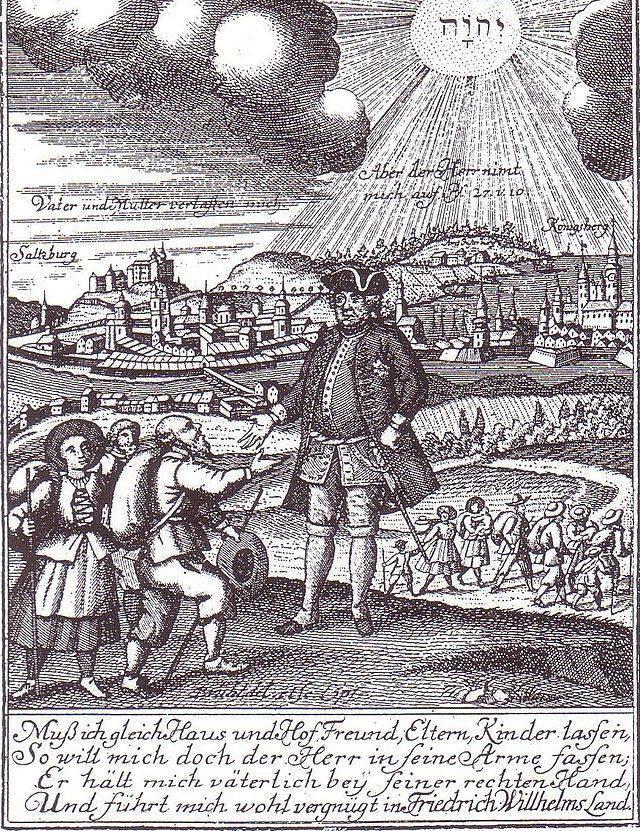
This was also very common in earlier centuries.
 |
| dansk english čeština عربي svenska português 中国人 magyar français |
| Contact More videos thanks to your support! |
 This was also very common in earlier centuries.
|
|
(by Nadja Laue)
When Luther's Reformation gained more and more support in Germany, this belief spilled over to Austria and Switzerland.
But the arch-conservative Catholic countries did not want to tolerate any reformatory wave. - They wanted to stick to the pope-loving faith. | But underground, in secret, there were people who followed Luther's teachings and preached according to his new guidelines. While the Peasants' War (1525-26) and then the Thirty Years' War (1618-48) were raging on German soil, the secret communities grew. And finally, in 1731, an oath of allegiance was demanded from the people of Salzburg (which we now want to take a closer look at here). | On August 5, 1731, the Protestants of Salzburg swore their allegiance. But the result was that the Protestants from Salzburg were no longer allowed to stay in their country. They didn't want a split in the church. - Large groups formed and in the end 20,000 people from Salzburg left their homeland. A mercy was given to them. They were allowed to leave their country with their belongings, taking their wives and children with them, as well as their livestock and all chattels. | In late autumn 1731 and winter 1732, the first 5,000 maids and servants were expelled from the country. Some of them were captured without warning and only released at the national borders. - But where should all the people go? 20,000 people wanted to be cared for and fed, wanted to live and work. So where could you have placed them? Actually, there was only one country that gladly accepted them back then: Prussia. - - At that time, Prussia was still in the process of being built up. Berlin was still a smaller city with little more than 5,000 inhabitants. | A great metropolis was to be built here. But without citizens, without people who brought taxes and labor into the country, this was hardly possible. On February 2, 1732, Friedrich Wilhelm I issued the Prussian invitation patent for the people of Salzburg. | The people followed the call of Prussia in droves. - At the same time, some residents of Salzburg went to the Netherlands or to America. | But we are interested in the big movement to Brandenburg and Prussia. Today one would simply board the plane or the train. Back then, people didn't have the opportunity to do that. - There were only your own feet, or those of the pack animal. After all, the people had to cover 640 km and that with a huge entourage of old people, women and children. | Food was scarce and one had to rely on the leniency of the people of the country one was passing through. - In order to arrive in the time frame specified by the Prussian king, you had to cover 25 km a day. A challenge for everyone involved. - In some places, refugees were accepted. Elsewhere, they had to steal from the trees on the road to get food. - Money and jewelry were soon sold and the proceeds eaten. Hunger and cold did the rest. In Leipzig, for example, they were well received, and Halle also took care of them. This was not uncommon in the Protestant country. The news of the outcasts came two days before the convoy. The places they traversed were prepared for the people. Weissenfels was also a route point on the way north. Two days before arrival, the city council had been informed that the people of Salzburg were coming. | The elders of the town hurriedly advised how to deal with the people and what could be given away from the town barns. - After a while the decision was made not to give anything away. You can't feed everyone. However, the procession was allowed to pass through the city, so there was no need to bypass the city. - The train came from Naumburg. In Naumburg they had camped on the Vogelwiese. Behind the town of Weißenfels (roughly at the top of Töpferdamm) there was an open space which was to be the next place for the refugees to spend the night. Weißenfels wasn't that big back then. The small suburbs that today belong to the city were called wild districts. - The Tüchner family lived in one of these districts. They were farmers, had a farm and two fields of land, which they farmed freely. - The courtyard must have stood in the area of today's Lassalleweg. The farmer, his wife and their 16 children lived on the farm. In addition, four eaters - relatives' children who would have starved to death in the city, the grandparents (both), six maids and three servants. It was a big household. There was always too little to eat. The convoy moved through the city for hours and then formed a huge group of wagons on the open space. Tents and tarpaulins were set up in the middle. | Many fires warmed and gave light. - The meager leftovers from Naumburg were distributed fairly among all. Tüchner was in town that day. He had bought a new plow there and was on his way home. He saw people, heard them speak and was touched. When he got home, he told his wife about the refugees. His wife packed a pannier with the freshly baked bread, milk from the cow in a clay jug and cheese, along with freshly hung sausages and a side of bacon. They were willing to give. They wanted to help in times of need. The Tüchnerin made her way to the entourage with the children. But as soon as she saw the light of the many fires, she realized that what she had brought with her would not be enough. So she sent the eldest son back home. Father and son opened the barn and packed grain and flour, cabbage and potatoes onto the wagon. - The servants caught the chickens from the farm and put them in chicken coops. - The maids fetched whatever was ripe and edible from the garden. They emptied the pantry and the chimney. | Even the sweet porridge from the oven was wrapped up. The grandfathers packed the pipe tobacco. The whole court carried and drove everything to the refugee camp. They even brought a pig with them. It was slaughtered that same evening. - They heartily gave what the city fathers had refused the refugees. After that they didn't even have a crust of bread at home. When the convoy moved on the next day, Tüchner made his way into town. He reports what he had done and that his family will now starve if the city does not help him. Ashamed, the councilors gave out what he had given. And more: the city councilors paid him the gift salary. Gift money means: If you give more than you can bear because your heart commands you to help without considering whether you might get into trouble yourself, the church pays the gift money. - These were two pieces of gold. - But Tüchner didn't want that. - He wondered what to do with the money. - And surely one could have used it at home. But the barn was full again. They did not suffer from hunger, thanks to the leniency of the city lords. So he returned it. However, not as blank. No! He wanted to remind you a little. He donated to the monastery church in Fenster. The Tüchner window showed a man handing gifts to another, in the background a carriage and horse, in front of other people. - A few weeks later, the Salzburgers arrived in Berlin and stayed there. Today you can still find descendants of the Salzburg family here and in Brandenburg. | The surnames indicate their origin. | Among them are the names Brandstädter, Brindlinger, Degner, Höfert, Hohenegger, Höll, Holle, Höllensteiner, Höllgruber, Hölzel, Holzinger, Holzlehner, Holzmann, Hopfgärtner, Hörl, Hoyer, Hubensatter, Huber, Leidreiter, Meyhöfer, Milthaler, Moderegger, Niederländer, Pfundtner, Scharffetter, Schindelmeiser, Schweinberger, Sinnhuber, Steinbacher, Turner and others Note from my side: When I first read the description of the window, I thought of the story of Joseph helping his brothers through the hunger in Egypt. However, the name Tüchner window pointed the way to the people of Salzburg. - The window is not listed in one of the first inventory lists of the monastery from 1596. However, the Tüchner window is mentioned in the demolition file (Office for Monument Protection). - It also mentions that it was dismantled and neatly packaged. It is not known where this stained glass window came from. Maybe it's in a village church in the area. | The church records from 1732 show the occurrence of Tüchner and the gift payment. | There are many other videos and stories here
» Midwife Executed For Abortion ... » Maid Killed By Church Tower ... » The Owl In The Church Tower ... » The Tüchner Window Of The Monastery Church ... » The Plague Raged And Took 99 Lives. Adam Degenkolbe Pro ... ページ更新: Judith Herrmann - 11.04.2023 - 00:06:58 |